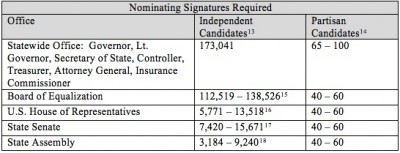Third Parties Argue Top-Two Primary Puts Them At a Disadvantage

At the end of May, the Green Party, Libertarian Party and Peace and Freedom Party released a joint statement on the effect of California’s top-two primary on third parties.
California top-two primary was adopted in 2010 and used for the first time during the 2012 elections. In their statement, the parties highlight three main areas in which they believe the new system has negatively impacted their participation in the electoral process.
It is now harder and more expensive third party candidate to qualify for the primary election ballot:
To be on the ballot, candidates from all parties have to pay afiling fee. Candidates can, however, submit a petition containing signatures in lieu of the fee. Under the new system, the required number of signatures was increased from 150 to 1,500 for an Assembly seat, 3,000 for a state Senate seat, and 10,000 for a statewide office.
Since the number of signatures required has increased, the filing, which is calculated on salary of the position the candidate is running for, has remained the same -- even diminished. The cost of this fee is approximately $3,480 for a U.S. Senate race, $1,740 for congressional, and $905 for California State Assembly and Senate.
While the filing fee and the costs of gathering signatures can be substantial for third parties, they remain a very small cost compared to the current level of campaign funding needed to win an election. According to MapLight and Follow the Money, in 2012, it cost, on average, $10,476,451 to win a seat in the U.S. Senate, $1,689,580 in the House, $564,105 in the California Senate, and $318,308 in the California Assembly.
The top-two primary makes it much harder for third parties to retain ballot status
Ballot status is the right by which a party is entitled to be on the ballot. A party can gain ballot access by receiving 2 percent of the vote in the general election for a statewide office or by having a number of registered voters equal to 1 percent of all the votes in the general election for a statewide office.
In California, in addition to the Democratic and Republican parties, four third parties are qualified to be on the ballot: the American Independent Party, the Green Party, the Libertarian Party, and the Peace and Freedom Party. Not being able to reach the November ballot will significantly reduce the capacities of these parties to remain a qualified in the future.
Under the top-two primary, however, being a qualified party only matters in the presidential primary; for all the other offices, the primary is now nonpartisan.
The top-two primary makes it almost impossible for third party candidates to appear on the general election ballot:
During the 2012 elections, no Green Party, Libertarian Party or American Independent Party candidate qualified for the November ballot. Three candidates from the Peace and Freedom Party finished in the top two, thereby gaining a spot on the November ballot.
Third parties argue against the top-two primary because it makes it harder for their candidates to be on the November ballot, where they can be visible to a much broader audience. Independent candidates have been making this exact same argument against the old electoral system.
To get on the November ballot under the previous system, independent candidates had to gather a disproportionate number of signatures compared to party candidates. Adding the strict rules surrounding signature gathering, getting on the November ballot was almost impossible for anybody running without a party.

As of February 2013
Third parties have been present in California's political environment for decades, but have never been able to really challenge the Democrats/Republicans' duopoly. While third party candidates argue "top-two" makes it harder for them to qualify for the November ballot, the new system offers more possibilities for change in California politics than maintaining the status quo. A change that will certainly be welcome by the millions of no party preference voters.



